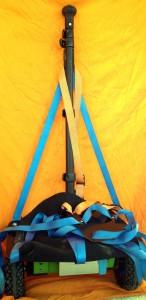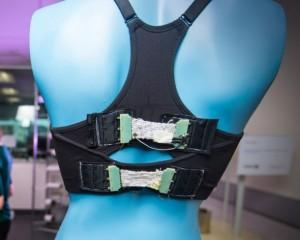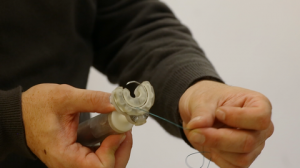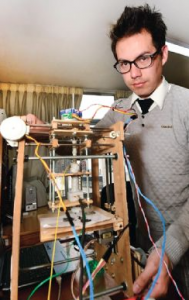In any emerging industry as transformative as 3D printing, the news just keeps rolling in and getting more exciting. Here at 3Dprint.com we do our best to keep our readers up to date with the latest breaking 3D printing news, but some stories slip past us while we are focused on other, oftentimes more important ones.
Every 3D printing enthusiast has a different idea of what they consider important news. You may be interested in big picture industry information, medical/ science/ military applications, 3D printed art and products, technical developments, educational opportunities or upcoming conferences. The good news is that while we may have missed many stories throughout the week, we are now taking the time to briefly catch you up on what we did not cover. Below you will find a comprehensive list of stories we did not have time to thoroughly cover during the week.
3D Printed eSherpa Trolley
Since 3D printing is “really going places”, we’ll start off with the news of a newly designed eSherpa trolley–that will help you with those heavy loads. We hear news all the time that technological innovation threatens human jobs. However, the heavy carrying of the notorious Nepalese sherpa might be one of those jobs that needs to be rethought for its human toll. Designer Ralf Naumann claims he made the electronic trolley, using 3D printed parts, because he “is lazy, clever, and old” — but from the looks of it, his laziness doesn’t seem readily apparent at all.
carrying of the notorious Nepalese sherpa might be one of those jobs that needs to be rethought for its human toll. Designer Ralf Naumann claims he made the electronic trolley, using 3D printed parts, because he “is lazy, clever, and old” — but from the looks of it, his laziness doesn’t seem readily apparent at all.
The Materials Sector Flourishing
The 3D printing materials sector of the industry is hardly lazy either, but instead growing steadily, according to a new report. This week’s big picture industry information is that the 3D printing materials sector will reach $1.052 billion by 2019. This report, published by MarketsandMarkets, states that plastics will still be the industry’s leading material, with ABS and PLA demand expected to grow. More expensive metals will remain in the high end industrial sector. 3D Systems and Stratasys (Plastics) and Arcam AB and ExOne GmbH (Metals) hold the largest market shares in their respective arenas.
Military Contracts with 3D Printing Companies
While it looks like the future remains squarely in plastics as the most commonly used 3D printing material, for the time being, the military continues to search for materials and applications that can aid soldiers in combat. This week it was announced that defense research and development firm Roke Manor Research Limited established a contract with the UK’s Defence Science and Technology Laboratory to conduct a military technology watch program aiming for 2030-2040. Roke has established a Techwatch web portal for any research organizations or companies to submit ideas.
The military contracts continue. In the United States, Manhattan-based Body Labs established a contract with the US Army’s Natick Soldier, Research, Development and Engineering Center (NSRDEC). It appears the Army finds Body Labs’ user-friendly platform for analyzing the anatomy and movement (fighting, jumping, running and more subtle movements) of the human body to be quite useful in the production of manufactured goods–such as body armor and equipment for a growing population of female soldiers. (Body Labs plans to release an API to 3D designers.) With more women joining the military, Body Labs plans to be at the forefront of the growing military design and manufacturing niche.
established a contract with the US Army’s Natick Soldier, Research, Development and Engineering Center (NSRDEC). It appears the Army finds Body Labs’ user-friendly platform for analyzing the anatomy and movement (fighting, jumping, running and more subtle movements) of the human body to be quite useful in the production of manufactured goods–such as body armor and equipment for a growing population of female soldiers. (Body Labs plans to release an API to 3D designers.) With more women joining the military, Body Labs plans to be at the forefront of the growing military design and manufacturing niche.
First Partially 3D Printed “Electromechanically Enhanced” Sports Bra Prototype
From military battles to the battle to find another kind of body armor–a properly fitting sports bra–the subject of female anatomy and 3D printing and women just got more interesting. This week CNN and many other news outlets covered the first 3D printed “Bionic Bra” (!) In a news release, Australian researchers announced an electromechanically enhanced, partially 3D printed sports bra made from sensors that tighten up when it detects increased motion.
got more interesting. This week CNN and many other news outlets covered the first 3D printed “Bionic Bra” (!) In a news release, Australian researchers announced an electromechanically enhanced, partially 3D printed sports bra made from sensors that tighten up when it detects increased motion.
Music Video Will Feature Ng’s 3D Printed Faces
The female form is clearly on the minds of 3D printing designers, while artist Melissa Ng focuses her 3D printing skills on different parts of human anatomy–the face! Her Lumecluster brand masks have already made their mark, and now she’s 3D printed 5 full color masks in sandstone, which will appear in an upcoming music video by JiHAE–a New York musician.
Dutch Artist Jansen’s “Strandbeest” Wows Miami
In other 3D printed art news, Dutch artist, Theo Jensen, made some waves during  this week’s Art Basel’s Miami Beach event with his “Strandbeest” or Beach Animal. We covered his artwork in an earlier piece, and his ideas and 3D applications continue to amaze and inspire people.
this week’s Art Basel’s Miami Beach event with his “Strandbeest” or Beach Animal. We covered his artwork in an earlier piece, and his ideas and 3D applications continue to amaze and inspire people.
Upcoming International Conferences
If being amazed and getting inspired by 3D printing is in the cards for you in early 2015–plan to attend either Las Vegas’ International Consumer Electronics Show, January 6-9, 2015 or Singapore’s Inside Printing Conference and Exposition, January 27-28, 2015. 3DPrint.com will have journalists on hand at CES in Vegas, and we are co-producing the Inside 3D Printing Show in Singapore.
3D Printed Suture Device to Restrict Needle Accidents
Both of those conference/ exposition events promise to highlight the latest and greatest 3D printing technology applications. And many will see how bright the future is for 3D printing’s medical and health applications. Sometimes its little devices that may fly under the radar but have a great impact on people’s lives. This week’s 3D printing medical news includes the invention of a 3D printed suture stitching device, by a company fittingly named  “Sutrue Ltd,” that will help prevent the now wide occurrence of needle stick injuries during suture procedures. The device contains the suture needle within a plastic cartridge, thus reducing the numbers of accidents when needles accidentally prick people and possibly transmit blood borne diseases. The inventor, Alex Berry, explains he printed his device prototype on a Form 1+ 3D printer and it took him about a week to develop a prototype for what would normally take six months without 3D printing.
“Sutrue Ltd,” that will help prevent the now wide occurrence of needle stick injuries during suture procedures. The device contains the suture needle within a plastic cartridge, thus reducing the numbers of accidents when needles accidentally prick people and possibly transmit blood borne diseases. The inventor, Alex Berry, explains he printed his device prototype on a Form 1+ 3D printer and it took him about a week to develop a prototype for what would normally take six months without 3D printing.
3D Printed Mobile Prosthetics Factory in Kenya
Other international medical/ health news includes Kenya-based 3D Life Print Project‘s announcement that they have developed a mobile 3D printed prosthetics factory that gets prostheses fitted, designed, and produced for patients who can be digitally tracked using SMS communication channels for pre and post care needs. This highly adaptable mobile system uses e-NABLE’s Raptor for body shape scanning and design, and it manufactures prosthetic models using the Ultimaker 2’s system.
Bolivian Student Builds 3D Printer Using Trash
In other young maker news, we are reminded how important it is to introduce students to 3D printing: they are the wave of future thinkers and makers, after all. One example of a young person’s contributions to the 3D printing space is Bolivian student, Paulo Loma’s, design for a cheap 3D printer–built from scratch  (costing around $70 altogether) that uses PET bottles (trash) as filament! This unnamed printer already has software to send and print assignments with, and although it is still in an early development phase, we look forward to seeing how his printer improves and what Loma decides to print with it. Using trash as filament, the landfills are the limit here!
(costing around $70 altogether) that uses PET bottles (trash) as filament! This unnamed printer already has software to send and print assignments with, and although it is still in an early development phase, we look forward to seeing how his printer improves and what Loma decides to print with it. Using trash as filament, the landfills are the limit here!
Printing Chocolate Just Got Refined
If your idea of 3D printing news lies in the culinary arena, printing with chocolate just became more refined as Open Electronics has modified the usual method. Valentine’s Day is fast approaching, so pay attention! Using the RepRap 3D printer, the 3Drag, and using a heated aluminum cylinder to keep chocolate at an even temperature of 32-33 degrees celsius, the only down side to this improved method is the slow printing time due to the need for heated chocolate to cool. With these improvements, you may be excited to start making those Valentine’s sweets early this year.
KeyTech Creates First “Food Safe” Certified PLA Filament
And finally, during this holiday season, if your idea of 3D printing includes visions of 3D printed sugar plum fairies, Italian company KeyTech has created the first “Food Safe” certified PLA filament so you can get busy making the stuff that your childhood holiday dreams are made of!
There you have it, the stories we failed to cover this week. We are no longer a failure!
Subscribe to Our Email Newsletter
Stay up-to-date on all the latest news from the 3D printing industry and receive information and offers from third party vendors.
You May Also Like
3D Printing Unpeeled: New Arkema Material for HP, Saddle and Macro MEMS
A new Arkema material for MJF is said to reduce costs per part by up to 25% and have an 85% reusability ratio. HP 3D HR PA 12 S has been...
3D Printing News Briefs, January 20, 2024: FDM, LPBF, Underwater 3D Printer, Racing, & More
We’re starting off with a process certification in today’s 3D Printing News Briefs, and then moving on to research about solute trapping, laser powder bed fusion, and then moving on...
3D Printing Webinar and Event Roundup: December 3, 2023
We’ve got plenty of events and webinars coming up for you this week! Quickparts is having a Manufacturing Roadshow, America Makes is holding a Member Town Hall, Stratafest makes two...
Formnext 2023 Day Three: Slam Dunk
I’m high—high on trade show. I’ve met numerous new faces and reconnected with old friends, creating an absolutely wonderful atmosphere. The excitement is palpable over several emerging developments. The high...































